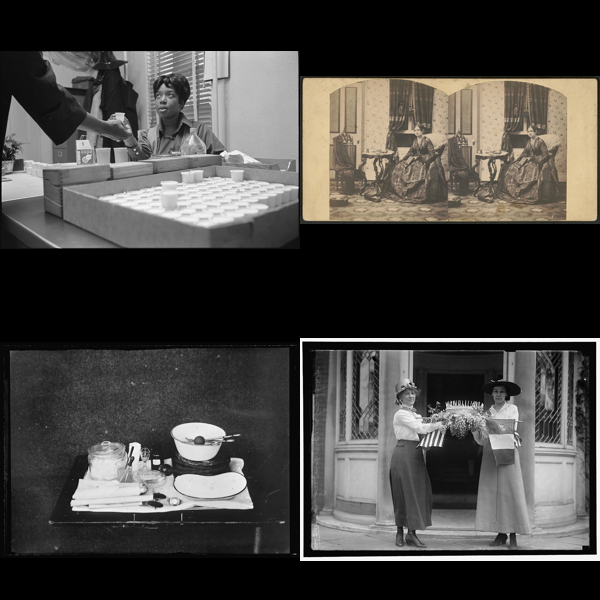LoC Data Package Tutorial: Free to Use collection#
This notebook will demonstrate basic usage of using Python for interacting with data packages from the Library of Congress via the Free to Use data package which is derived from the Library’s Free to Use and Reuse Sets. We will:
Prerequisites#
In order to run this notebook, please follow the instructions listed in this directory’s README.
Output data package summary#
First, we will select Free to Use Data Package and output a summary of it’s contents
import io
import pandas as pd # for reading, manipulating, and displaying data
import requests
from helpers import get_file_stats
DATA_URL = 'https://data.labs.loc.gov/free-to-use/' # Base URL of this data package
# Download the file manifest
file_manifest_url = f'{DATA_URL}manifest.json'
response = requests.get(file_manifest_url, timeout=60)
response_json = response.json()
files = [dict(zip(response_json["cols"], row)) for row in response_json["rows"]] # zip columns and rows
# Convert to Pandas DataFrame and show stats table
stats = get_file_stats(files)
pd.DataFrame(stats)
| FileType | Count | Size | |
|---|---|---|---|
| 0 | .jpg | 2,610 | 1.06GB |
Query the metadata in a data package#
Next we will download a data package’s metadata, print a summary of the items’ subject values, then filter by a particular subject.
All data packages have a metadata file in .json and .csv formats. Let’s load the data package’s metadata.json file:
metadata_url = f'{DATA_URL}metadata.json'
response = requests.get(metadata_url, timeout=60)
data = response.json()
print(f'Loaded metadata file with {len(data):,} entries.')
Loaded metadata file with 2,610 entries.
Next let’s convert to pandas DataFrame and print the available properties
df = pd.DataFrame(data)
print(', '.join(df.columns.to_list()))
Call_number, Contributors, Date_text, Date, Digitized, Set, Genre, Id, IIIF_manifest, Preview_url, Index, Other_title, Description, Creators, Type_of_resource, Location_text, Other_record_formats, Rights, Source_collection, Language, Lccn, Medium, Mime_type, Notes, Online_format, Original_format, Part_of, Repository, Number_of_files, Shelf_id, Subjects, Subject_headings, Last_updated_in_api, Title, Url, Location
Next print the top 10 most frequent Subjects in this dataset
# Since "Subjects" are a list, we must "explode" it so there's just one subject per row
# We convert to DataFrame so it displays as a table
df['Subjects'].explode().value_counts().iloc[:10].to_frame()
| Subjects | |
|---|---|
| united states | 1073 |
| color | 827 |
| photographic prints | 332 |
| portrait photographs | 265 |
| america | 236 |
| glass negatives | 230 |
| digital photographs | 200 |
| american | 166 |
| washington (d.c.) | 153 |
| new york (state) | 143 |
Now we filter the results to only those items with subject “washington (d.c.)”
df_by_subject = df.explode('Subjects')
dc_set = df_by_subject[df_by_subject.Subjects == 'washington (d.c.)']
print(f'Found {dc_set.shape[0]:,} items with subject "washington (d.c.)"')
Found 153 items with subject "washington (d.c.)"
Download and display images#
First we will merge the metadata with the file manifest to link the file URL to the respective item.
df_files = pd.DataFrame(files)
dc_set_with_images = pd.merge(dc_set, df_files, left_on='Id', right_on='item_id', how='inner')
print(f'Found {dc_set_with_images.shape[0]:,} dc items with image files')
Found 153 dc items with image files
Finally we will download and display the first 4 images that have subject “washington (d.c.)”
import math
from IPython.display import display # for displaying images
from PIL import Image # for creating, reading, and manipulating images
count = 4
dc_set_with_images = dc_set_with_images.head(count).reset_index()
# Define image dimensions
image_w = 600
image_h = 600
cols = math.ceil(count / 2.0)
rows = math.ceil(count / 2.0)
cell_w = image_w / cols
cell_h = image_h / rows
# Create base image
base_image = Image.new("RGB", (image_w, image_h))
# Loop through image URLs
for i, row in dc_set_with_images.iterrows():
file_url = f'https://{row["object_key"]}'
# Downoad the image to memory
response = requests.get(file_url, timeout=60)
image_filestream = io.BytesIO(response.content)
# And read the image data
im = Image.open(image_filestream)
# Resize it as a thumbnail
im.thumbnail((cell_w, cell_h))
tw, th = im.size
# Position it
col = i % cols
row = int(i / cols)
offset_x = int((cell_w - tw) * 0.5) if tw < cell_w else 0
offset_y = int((cell_h - th) * 0.5) if th < cell_h else 0
x = int(col * cell_w + offset_x)
y = int(row * cell_h + offset_y)
# Paste it
base_image.paste(im, (x, y))
# Display the result
display(base_image)
